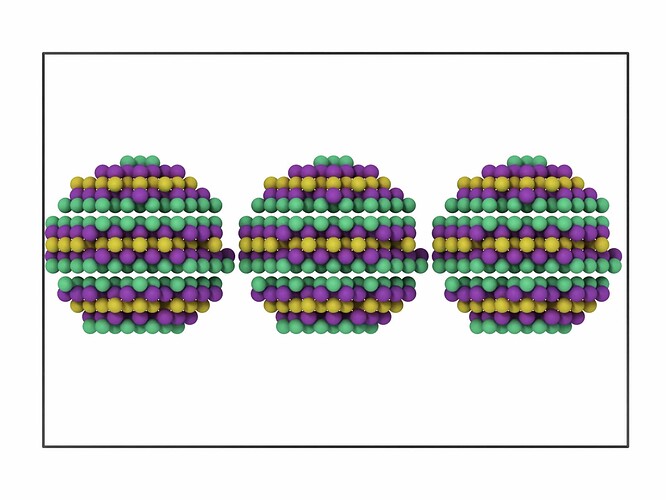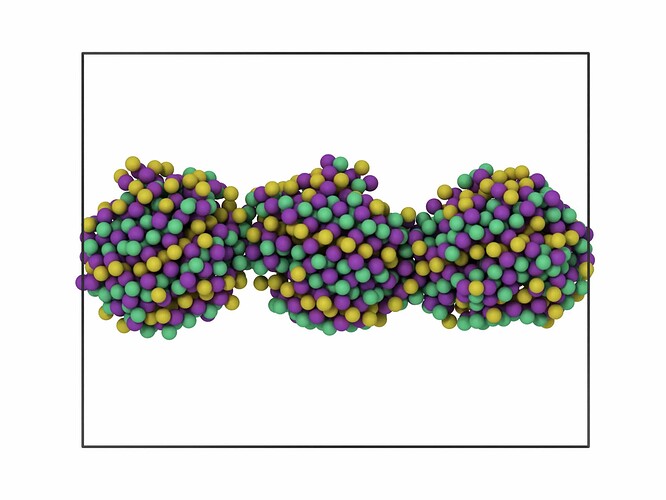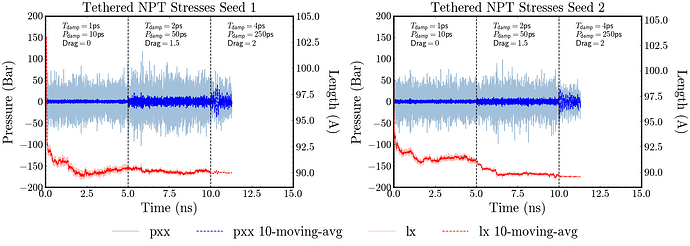Hello all,
I am trying to measure the thermal conductivity along the x-direction for a group of 3 ‘nano-particles’ of Bi2Te3 with periodic boundaries along x & y and slab boundary along z. The workflow for this system set up is as follows:
- Generate particle chain and relax x-direction via NPT with a fix spring tether command for each nanoparticle group to keep their y and z com coordinates the same throughout relaxation along the x-axis
- Relax in NVT while removing the tether to ensure chain slowly relaxes followed by equilibration in NVE before production phase
- Production NVE where I measure the heat-flux and then compute thermal conductivity via the green-kubo relations
Below are my NPT and NVT relaxation scripts:
NPT:
units metal
dimension 3
boundary p p f
atom_style charge
processors 3 2 1
pair_style hybrid/overlay morse 5.5 coul/long 12
neigh_modify every 1 delay 0 check yes page 100000 one 10000
neigh_modify exclude none
pair_modify shift yes
kspace_style pppm 1.0e-4
kspace_modify slab 3.0
read_data chain_3.data
# type 1 = Bi
# type 2 = Te1
# type 3 = Te2
pair_coeff * * coul/long
pair_coeff 1 1 morse 0.085 2.212 4.203 5.5 # type1 type2 D a r_0 r_cutoff
pair_coeff 2 2 morse 0.076 1.675 3.642 5.0
pair_coeff 3 3 morse 0.066 2.876 4.312 5.0
pair_coeff 1 2 morse 0.975 1.285 3.089 4.0
pair_coeff 1 3 morse 0.582 1.257 3.251 4.0
pair_coeff 2 3 morse 0.807 0.731 4.497 5.5
timestep 0.0005 # 0.5 femtoseconds
thermo 5000
variable ke equal ke
variable pe equal pe
variable etotal equal etotal
variable volume equal vol
variable pxy equal pxy
variable pxz equal pxz
variable pyz equal pyz
variable pxx equal pxx
variable pyy equal pyy
variable pzz equal pzz
# Groups for particle chains
group 1 id 1:473
group 2 id 474:946
group 3 id 947:1419
fix pull_1 1 spring tether 1.0 NULL 22.3457853 31.32114068 0
fix pull_2 2 spring tether 1.0 NULL 22.3457853 31.32114068 0
fix pull_3 3 spring tether 1.0 NULL 22.3457853 31.32114068 0
fix track_energies all ave/time 1 1 20000 v_ke v_pe v_etotal file tether_npt_energies.dat
dump mydump all custom 200000 tether_npt_configs.dat type q x y z # every 100 ps
dump_modify mydump sort id
fix my_npt all npt temp 300.0 300.0 $(500.0*dt) x 0 0 $(5000*dt) # Slower equilibration
# Zero net linear and angular momentum
velocity 1 zero linear
velocity 1 zero angular
velocity 2 zero linear
velocity 2 zero angular
velocity 3 zero linear
velocity 3 zero angular
compute my_stress all pressure thermo_temp
fix track_stress all ave/time 400 10 20000 c_my_stress[1] c_my_stress[2] c_my_stress[3] c_my_stress[4] c_my_stress[5] c_my_stress[6] file tether_npt_stresses.dat
run 10000000 # 5 ns
write_data rNEMD_npt_equil.data
NVT:
units metal
dimension 3
boundary p p f
atom_style charge
pair_style hybrid/overlay morse 5.5 coul/long 12
neigh_modify every 1 delay 0 check yes page 100000 one 10000
neigh_modify exclude none
pair_modify shift yes
kspace_style pppm 1.0e-4
kspace_modify slab 3.0
read_data rNEMD_npt_equil.data
# type 1 = Bi
# type 2 = Te1
# type 3 = Te2
pair_coeff * * coul/long
pair_coeff 1 1 morse 0.085 2.212 4.203 5.5 # type1 type2 D a r_0 r_cutoff
pair_coeff 2 2 morse 0.076 1.675 3.642 5.0
pair_coeff 3 3 morse 0.066 2.876 4.312 5.0
pair_coeff 1 2 morse 0.975 1.285 3.089 4.0
pair_coeff 1 3 morse 0.582 1.257 3.251 4.0
pair_coeff 2 3 morse 0.807 0.731 4.497 5.5
timestep 0.0005 # 0.5 femtoseconds
thermo 5000
variable ke equal ke
variable pe equal pe
variable etotal equal etotal
variable volume equal vol
variable pxy equal pxy
variable pxz equal pxz
variable pyz equal pyz
variable pxx equal pxx
variable pyy equal pyy
variable pzz equal pzz
# Groups for particle chains
group 1 id 1:473
group 2 id 474:946
group 3 id 947:1419
fix pull_1 1 spring tether 1.0 NULL 22.3457853 31.32114068 0
fix pull_2 2 spring tether 1.0 NULL 22.3457853 31.32114068 0
fix pull_3 3 spring tether 1.0 NULL 22.3457853 31.32114068 0
fix track_energies all ave/time 1 1 20000 v_ke v_pe v_etotal file tether_nvt_energies_1.dat
dump mydump all custom 200000 tether_nvt_configs_1.data type q x y z
dump_modify mydump sort id
fix my_nvt all nvt temp 300.0 300.0 $(1000.0*dt) # Slower equilibration
# Zero net linear and angular momentum
velocity 1 zero linear
velocity 1 zero angular
velocity 2 zero linear
velocity 2 zero angular
velocity 3 zero linear
velocity 3 zero angular
run 200000 # 100 ps
unfix pull_1
unfix pull_2
unfix pull_3
velocity all create 300.0 704812 # Regenerate velocities
# Zero net linear and angular momentum
velocity 1 zero linear
velocity 1 zero angular
velocity 2 zero linear
velocity 2 zero angular
velocity 3 zero linear
velocity 3 zero angular
variable ang_1 equal angmom(1,x)
variable ang_2 equal angmom(2,x)
variable ang_3 equal angmom(3,x)
compute my_stress all pressure thermo_temp
fix track_angmoms all ave/time 2000 10 20000 v_ang_1 v_ang_2 v_ang_3 file tether_angmoms_1.dat
fix track_stress all ave/time 2000 10 20000 c_my_stress[1] c_my_stress[2] c_my_stress[3] c_my_stress[4] c_my_stress[5] c_my_stress[6] file tether_stresses_1.dat
run 12000000 # 6 ns
write_data rNEMD_nvt_equil_1.data
What is most curious about my set-up is that it seems depending on what velocity seed I use, I can generate initial conditions that lead to the chain rapidly rotating about the x-axis, with increasing rotations over the trajectory.
Here is the angular momentum plotted throughout the NVT trajectory over 12 random-seeds, with the average across the 12 seeds in dashed-red, each separate plot corresponds to one of the three particles in the 3-particle chain:
Which lead to widely different final thermal-conductivity estimates:
The 0 estimates along y and z give me confidence my simulations are not fundamentally incorrect as the finite length along both directions for the chain necessarily must give 0 thermal conductivity, so I have no clue why 2 of the 12 random seeds, with one in particular, absolutely blows up due to whatever random velocity seed I assigned to it.
Has anyone ever experienced a problem like this before? My first thought was there must be some type of in-phase perturbation that continues to grow throughout the simulation time, but I wasn’t able to find anything similar, albeit I don’t really know the correct terminology to describe what I’m seeing. Thanks for any insight someone is able to provide on this!




